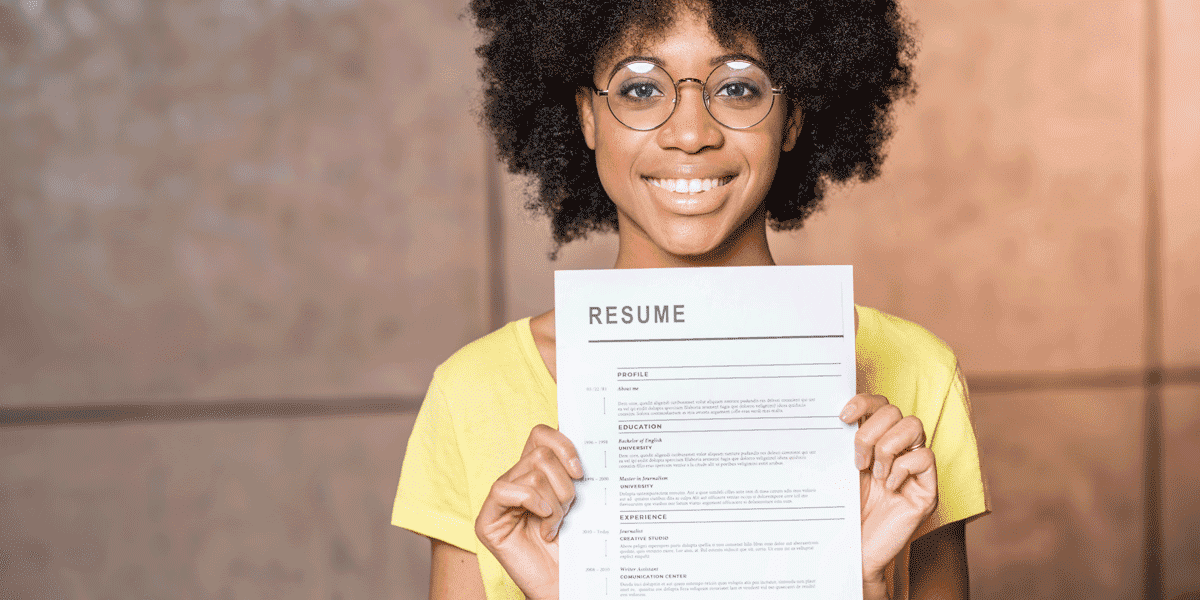I’ve been working with a student who has been part of the service industry all her life. She is now training to become a certified UX designer and is naturally nervous about her resume.
What will her resume look like? What skills can she include that will be attractive to hiring managers? Is any of her experience in the service industry worth sharing?
It’s natural to feel nervous about your new UX design resume, especially when you have little to no experience in the field. However, user experience design is a multidisciplinary field which draws upon skills you can develop in nearly every other industry. Without a doubt, there’ll be something in your background you can build your new resume with.
In this guide, we’ll cover:
- The ground rules of writing a UX resume
- How to structure your UX resume
- The most important skills to highlight in your UX resume
- The importance of storytelling
- Next steps
Before we dive in, you might find this video useful. In it, seasoned UX designer Dee Scarano analyzes three real UX design job ads (posted by Amazon, Deloitte, and Adobe) and talks us through what the hiring managers behind these roles are really looking for. When writing your UX resume, it’s important to tailor it to the job you’re applying for, so this video will set a good stage:
Now, let’s jump into those resume-writing tips.
1. Designing a winning UX Resume: The ground rules
Before we look into what information to include, how to approach your layout, and other essential tips to design a winning resume, let’s go over the basics.
Avoid typos
This one goes without saying, but you’d be amazed by how many resumes are still plagued by typos. Double check your spelling and grammar.
Read your resume out loud. Does it sound funny? If it does, rewrite it. Ask a buddy to read it and have them provide feedback. Is it clear? Did they catch any spelling mistakes?
Run your text through Grammarly. I love this tool! It makes writing simple, helps me become a better writer, and saves me from embarrassing typos I may not catch.
Keep an eye on your design
Yes, you’re training to become a UX Designer, not a visual designer. However, your resume should still feel designed.
Not feeling confident about your visual design skills? Here are a few tips that will have you covered:
- Keep an eye on the alignment
- Use one typeface and its different weights to create a strong visual hierarchy. Use bold for job titles, for example, and regular for your job description
- Avoid a varied palette. I recommend sticking to black and white
If, after trying to design your resume yourself, you are still not feeling confident, try a tool like Canva.
Stick to one page
This one is probably the most challenging for most of my students. However, I can’t stress how important it is. Too many pages can be overwhelming and hard to digest.
Keep your resume concise, clean, and simple. Get rid of old jobs and irrelevant experiences. Make your hiring manager’s job easy!

2. Structuring your UX resume
The order of the content you include on your resume matters and should be carefully thought out. Your resume should read from the top down. I recommend following this structure:
1. Name, title, and contact information
What is your full name? And profession? And how do we get in touch with you?
2. Experience in chronological order
List your job title, your employer’s name, starting and end date, and the location. Include a concise description of your key responsibilities.
3. Education
Include the name of the institution, the kind of degree or certification, and starting and end date.
4. Awards and professional development
Have you ever won an award? Share it, even if it is not design related. Are you involved in any organizations, clubs, meetups, or in your community in any way? Tell us about it!
5. Skills and tools
List your UX skills, like user research, wireframing, and prototyping. Under tools, detail the software you are proficient in and use as a UX designer.
6. Other languages
Habla español? The Spanish market is enormous these days. Multilingual designers are attractive to employers.
3. How can you make sure your UX designer resume stands out? Highlight these key skills
Many of my students tend to worry more about learning design software than on developing fundamental skills. The truth is, proficiency in design software won’t make you a good UX designer and will not get you hired. The right skillset, not a toolset, will. You’ll want to highlight these in your resume. This is great news for career changers who have little to no prior experience in UX design, because you’re transferable skills play a big part in preparing you for UX design roles.
When looking at your prior experience, ask yourself if you have ever:
- Collaborated on a project
- Conducted research
- Written any kind of content
- Had to communicate with others
- Planned anything
- Analyzed data or reports
- Had to solve a problem
- Interviewed someone
- Had to connect the dots
If you’ve answered yes to any of many of these, chances are you’ve developed skills desirable in a UX design candidate. Great UX designers:
- Write clearly
- Have strong communication skills
- Know how to structure and conduct research
- Have strong logic and reasoning skills
- Are empathetic
- Are good listeners
- Have strong analytical skills
- And here is a classic one: are great problem solvers
You don’t have to be a practicing designer to have the skills listed above. It is highly likely that you’ve developed these through prior, non-design related experience. Highlight them in your resume!

4. The secret to a winning UX resume? Storytelling!
When building your UX resume, it’s important to focus on telling a story. Especially if you’re coming from a non-design background, you’ll need to weave a coherent narrative that shows your journey into UX design. No matter what you’ve studied or where you’ve worked previously, you are bound to have mastered a whole host of transferable skills that make you an invaluable designer—so emphasize these in your resume! Show how your previous experience has led you to UX.
If you’re a new UX designer, it’s also perfectly fine to list any skills or tools that you’re in the process of learning. Ultimately, the hiring manager wants to get a good impression of who you are as a designer, so use your resume as a storytelling tool. Don’t forget to include a link to your portfolio, too!
5. Creating your UX resume: Next steps
Updating and writing a resume can be overwhelming. If you’re on this boat, try heading out to your favorite cafe with your sketchbook and pencil. With a latte in hand, sketch your way through your resume. Don’t worry about being tidy or sketching up a Picasso—focus on developing a clear structure and figuring out what will go where.
Once you’re happy with it, go digital. Begin to focus on your writing and on a clean layout. You’ll be done in no time!
For more tips on how to market yourself as a UX designer, take a look at the following guides:
